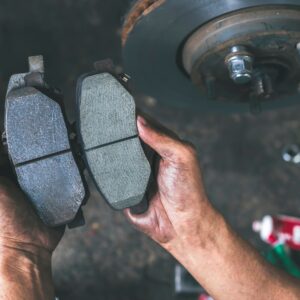It’s important to stay on top of the list of maintenance tasks connected to your vehicle’s brakes. After all, they’re all that’s keeping your vehicle from spinning wildly out of control or ramming into another vehicle on the road. The brake pads, in particular, must be replaced as soon as they develop issues to ensure optimal braking performance.
How Many Brake Pads Are on a Vehicle?
In most cars, wheel calipers have two brake pads each, one inner pad and one outer pad. That means vehicles with only front disc brakes have four brake pads, and vehicles with front and rear brakes have eight brake pads.
Many modern vehicles with electronic parking brakes have additional parking brake calipers on their rear wheels, which is an additional four brake pads. Certain sports vehicles have even more brake pads to handle the more extreme conditions in which they need to brake.
How Do Brake Pads Work?
Brake pads are simple components connected behind each of your vehicle’s wheels. Each brake pad has a single metal backing plate with a friction material attached.
Brake pads connect to the brake calipers, which squeeze them against the disc-shaped rotor on your vehicle’s wheels. The resulting friction stops the vehicle. Brake pads go under frequent, extreme stress every time you press on the brakes to slow or stop your vehicle, which is why they wear down.
Here are some of the brake pad types out there:
- Non-metallic brake pads are made from various materials. They are the least expensive and are the quickest to wear out.
- Semi-metallic brake pads last longer than non-metallic brake pads and offer better performance at the cost of noise and extra dust.
- Ceramic brake pads perform incredibly well with less dust and are more expensive.
Do Brake Pads Wear Down Evenly?
Brake pads are supposed to wear out evenly, and they typically need to be replaced every 30,000 to 35,000 miles in regular, urban use. They’re designed so the brake system applies equal brake pressure to each of the vehicle’s sides.
If your vehicle’s brake pads are wearing out unevenly, it likely means something is amiss in the braking system.
It’s possible that your vehicle is misaligned, which means its front wheels are pulling to one side and causing difficulty driving. Some slide pins might also be corroded, keeping the caliper from moving back and forth properly. Sticky caliper pistons, meanwhile, won’t slide smoothly and will cause the brake pads to stick to the rotor.
Worn Brake Pad Symptoms
There are a number of symptoms that can point to faulty or worn brake pads. These include the following situations:
- Bad grinding, squealing, or clunking noises while braking
- Visible wear on friction surfaces
- Odd brake pedal feel
- Pulsing or vibrating while braking
- The vehicle pulls to one side while braking
- Low brake fluid level
Should You Replace All Your Brake Pads at Once?
You’ll often find that replacing all your brake pads at once rather than one pad at a time can save you more money in the long run.
If you replace only one or two pads at a time, the new pads will be more efficient than the old pads, meaning they’ll grip the rotors better. This can cause uneven braking performance, which will feel unstable and can be unsafe.
If you bring your vehicle to an auto repair shop, mechanics can work efficiently and replace all the brake pads at once while your vehicle is in their shop. This saves you the back and forth when your other brake pads inevitably need changing. Moreover, getting a brake pad set is often cheaper than buying brake pads one by one.
Are Front and Rear Brake Pads Interchangeable?
If you’re looking to replace your vehicle’s brake pads yourself, or you plan to buy the brake pads for a mechanic to install, make sure to buy the correct ones. After all, the brake pads on a heavy-duty truck will differ from those on a compact car. Front and rear brake pads are also not the same.
Front brake pads are often larger and are made with more aggressive compounds to increase their friction capabilities. Rear brake pads, on the other hand, are smaller with decreased friction to stabilize your vehicle during heavy braking.
All of these factors account for the fact that vehicles usually place more pressure on the front pads than the rear pads. You cannot use front brake pads on rear tires.
Can You Replace Your Brake Pads Yourself?
Replacing your brake pads yourself is a doable project as long as you’re handy with a wrench and know what you’re doing. However, because the brakes are a critical system, you ought to seriously consider simply taking your vehicle to an auto repair shop if you lack confidence or experience.
While many people tackle changing their brake pads after other beginner DIY projects like changing their engine oil, you must not forget that these are the brakes we’re talking about. If anything goes wrong, it could spell disaster.
Now that you know more about brake pads and how many you might need to change, you can decide if it’s a project worth tackling in your garage.
Any information provided on this Website is for informational purposes only and is not intended to replace consultation with a professional mechanic. The accuracy and timeliness of the information may change from the time of publication.


































